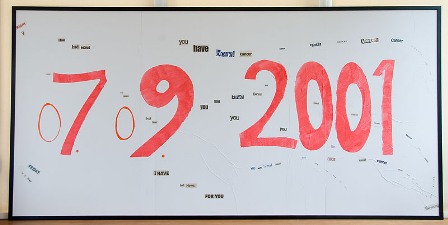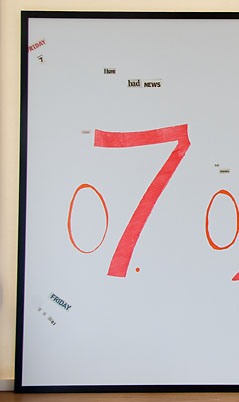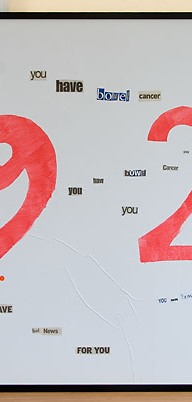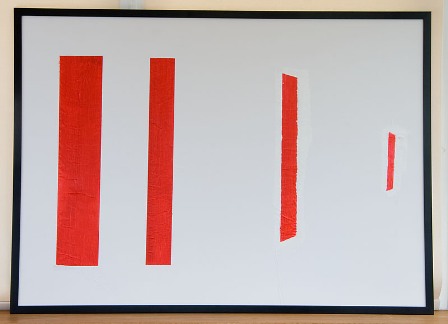Section 1
1. D-day

On Friday 7th September 2001 I was diagnosed with “bowel cancer”. I was only 33 years of age.
This piece illustrates the massive impact of September 7th 2001 on my life; even now, 10 years on, the date 7th September, looms large. As each anniversary of my diagnosis draws near, I again remember the events of that day. The intensity of the emotions I feel has diminished with time, but the date continues to stand out for me. Hence the physical size of the date (written in British- rather than American- date format!)
I still vividly remember the surgeon telling me my diagnosis- it stands out like a newsflash, a newspaper headline. As a medical student, I had excelled in pathology; I remembered much of what I had been taught many years previously about bowel cancer. I asked the surgeon what he planned to do. It took me about 5 minutes before I actually blurted out: “But I’m only 33 years old”. To my mind, I was way too young to have bowel cancer.
Four days later, the events of September 11th 2001 unfolded. The news reporters described the aftermath of the attacks on the World Trade Centre and attempted attacks on the Pentagon, as changing the world forever. In the days, weeks months and years following September 11th 2001, it became apparent just how much the world had changed.
But my
world was completely and utterly torn apart four days before that. Just how
much my world was changed by my diagnosis also only became apparent over the
following days, weeks, months and years.
 |  |
Section 1
2. 28 Days

This piece expresses my experience in hospital: a mish-mash of physical sensations and emotional reactions.
In all my art work, each colour has a meaning- red is (physical) pain (or later, not in this piece, anger); blue is sadness; black is fear; the deep blue/black combined colour in this piece represents the utter isolation, a feeling of desolation that I felt; light green to me is life, the essence of created life; white is God, the God of the Bible. In the midst of the torrent of experiences and emotions, I felt God with me, ever-present, but in the background, not removing me from my difficult situation or emotions.
You may see the very thin line of green, running from top left to bottom right in this piece, becomes very difficult to make out, and is almost obscured by the other colours in the middle; for the first 2-3 weeks I was in hospital, due to various complications, my strength and will to live was sapped such that it almost disappeared completely. I gradually gained some strength after having calories through the central line (special drip) for a week or so. By the time I was discharged, I could only just manage to climb a flight of stairs; I felt about 90 years old…..
Section 1
3. Opening Lines

(Acrylic on printpaper; 40 inches wide x 29 1/2 inches high)
Between 15th September 2001 and 26th November 2002 I had four (two emergency and two “elective”) operations. These remain as vivid gashes in my memory.
While in hospital, I experienced some very poor nursing care (especially at night). The nurses refused to listen to me when I tried to explain I had severe pain less than forty-eight hours after my initial operation. The reason for the pain only became fully apparent when eventually I had further emergency surgery four days later. The fact my first two operations had to be carried out as emergency procedures exaggerated the feeling of shock and pain.
In addition, the fact that complications resulted in my wounds taking many months to fully heal, and resulted in my requiring two further operations, only exaggerated the impact of the operations on my life after discharge from hospital.
The fact that further (less serious) complications occurred after my two elective operations, and nursing staff again did not listen to me when I asked for help, reinforced the pain and distress associated with my operations.
Section 1
4. Life Flow
During a large part of my time in hospital, I was unable to absorb what I ate or drank. Life-saving fluids, salts, antibiotics and (later) calories were given by a “drip” (intravenously) for more than three weeks.
For the first 2 weeks that I was in hospital, I felt my strength and energy, and sense of being alive, drain away; even when I was allowed to eat and drink, my body seemed unable to tolerate what it was given. In addition, infection was draining energy that I simply did not have, and I was wasting away. On Friday 28th September the surgeon inserted a special line- a “central line”- (under sedation) into a vein in my neck, through which I was then given calories (“parenteral nutrition”). The energy from this enabled my body to fight the infection and I gradually gained strength. As the infection eased and my strength returned, I was gradually able to eat and absorb food, so that the central line was able to be removed after one week. It was a further week before I was able to be discharged from hospital. When I was discharged from hospital, I was very weak- it took a very long time for my strength to return.
In this piece, each bag of infusion fluids represents one day that I was in hospital. The green colour represents my life, the essence of my being. The bags become more empty, and the colour becomes lighter and lighter as my strength was drained by infection and being unable to absorb food. As my strength gradually returned (after the “central line” had been inserted), so the colour in the infusion bags becomes slightly darker, and the bags of fluid more full. Even so, at the time I was discharged, I was still very weak, so the bags are not full, and the colour is still very light.
Section 1
5. Sore Point

This piece is made from cannulae (“drips”) and needles similar to those which were used on me, randomly inserted into clay.
In my time in hospital, I had blood tests taken and a new “drip” put in once or twice per day. The junior doctors who came to do these seemed both incompetent at performing the procedures and oblivious to the pain and distress they were causing me. There were multiple occasions where I had to help the doctor by holding his (her) hand to ensure they got the needle in the right place?! I knew that the procedures had to be done, but still found it difficult to face when the staff came to do them. As a result, these seemingly-small procedures felt like “torture” and they still haunt me.
I later learned that usually it was not the junior doctors who inserted cannulae, but nursing staff. However, it seems the nurses were unwilling to insert the cannulae or take blood from me because I was a doctor. Hence I suffered more because I was a doctor.
Since my experience, I am more keenly aware of the trauma that taking blood and having “drips” put in can cause. I seek to minimise the distress which my patients (and their parents) experience when having these necessary procedures done. I hope my patients suffer less as a result of my experience.
